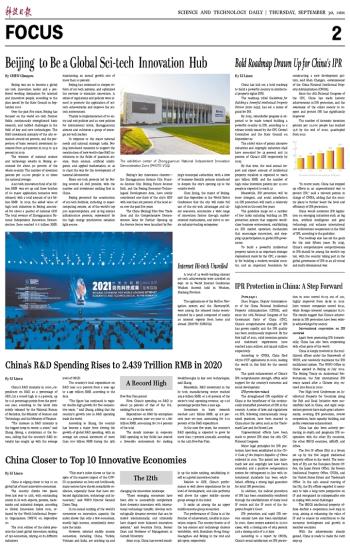
 |
| The exhibition center of Zhongguancun National Independent Innovation Demonstration Zone. (PHOTO: VCG) |
Beijing was set to become a global sci-tech innovation leader and a preferred working destination for talented and innovative people, according to the plan issued by the State Council in September 2016.
Over the past five years, Beijing has focused on the world sci-tech frontier fields, continuously strengthened basic research, and tackled challenges in the field of key and core technologies. The R&D investment intensity of the city remained around six percent, and the proportion of basic research investment increased from 13.8 percent in 2015 to 15.9 percent in 2019.
The winners of national science and technology awards in Beijing accounted for about 30 percent of the whole country. The number of invention patents per 10,000 people is 10 times the national average.
A sci-tech innovation fund of 30 billion RMB was set up and three batches of 60 major application scenarios were released, with a total amount of 19.6 billion RMB. In 2019, the added value of high-tech industries in Beijing accounted for about a quarter of national GDP. The total revenue of Zhongguancun National Independent Innovation Demonstration Zone reached 6.6 trillion RMB, maintaining an annual growth rate of more than 10 percent.
Beijing has continued to deepen reform of sci-tech systems, and optimized the services to stimulate innovation. A series of regulations and policies were issued to promote the application of sci-tech achievements and improve the sci-tech environment.
Thanks to implementation of 20 entry and exit policies and 20 new policies for international talent, Zhongguancun attracts and cultivates a group of strategic sci-tech leaders.
In response to the major national needs and national strategic tasks, Beijing introduced measures to support the construction of new world-class R&D institutions in the fields of quantum science, brain science, artificial intelligence, and applied mathematics, so as to chart the way for the development of national laboratories.
Major sci-tech projects led by Beijing covered all civil projects, with the number and investment ranking first in China.
Beijing promoted the construction of sci-tech facilities, including 12 supercomputing centers, 46 of the world's top 500 supercomputers, and 19 big science infrastructure projects, represented by the high-energy synchrotron radiation light source.
Beijing's key innovation clusters—the Zhongguancun Science City, Huairou Science City, Beijing Future Science Park, and the Beijing Economic-Technological Development Area, have jointly contributed one-third of the city's GDP with less than six percent of the land area over the past five years.
The China (Beijing) Pilot Free Trade Zone and the Comprehensive Demonstration Zone for Further Opening up the Service Sector were launched by Beijing's municipal authorities, with a slew of business-friendly policies introduced to deepen the city's opening up to the outside world.
Chen Jining, the mayor of Beijing, said this September at the World Robot Conference that the city will make full use of the sci-tech advantages and talent resources, accumulate a wide range of innovation factors through market-oriented mechanisms, and strive to create industry-leading enterprises.


 Next
Next




